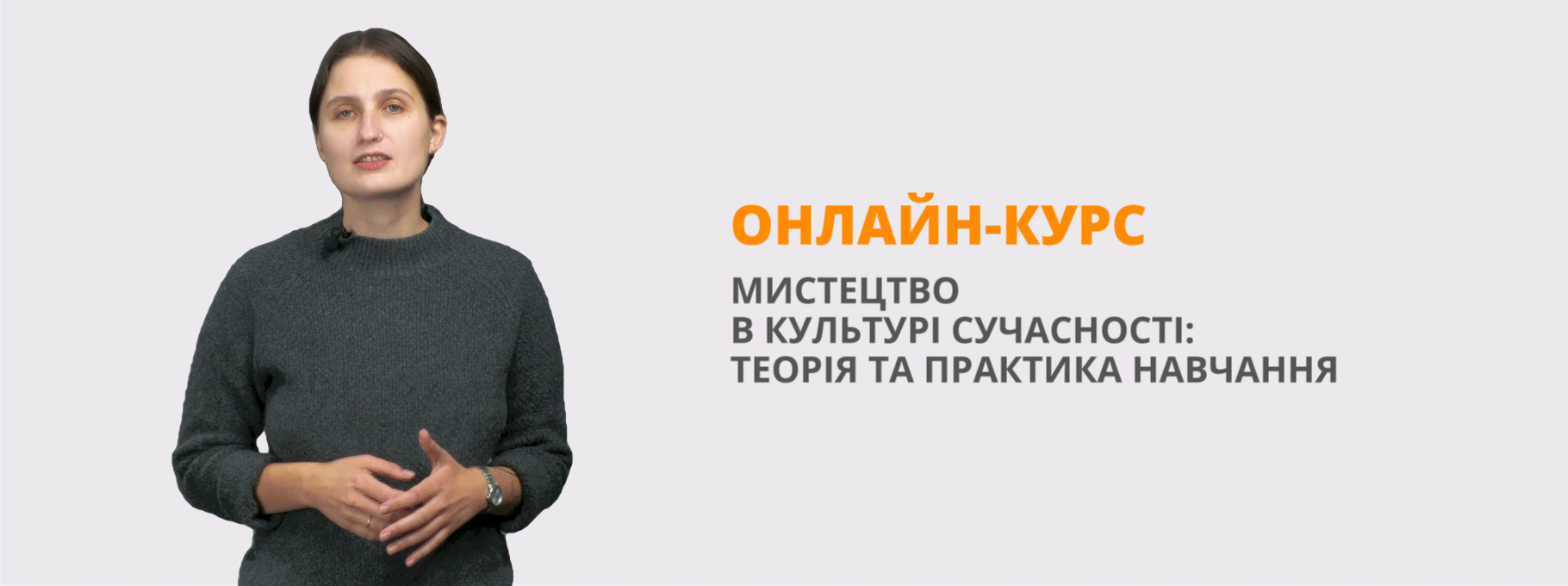Брейн-ринг з англійської мови "London – the Capital of the United Kingdom of Great Britain and Northern Ireland"
Підготувала Калінцова В.В., вчитель англійської та німецької мови КЗ «Зорянська загальноосвітня школа І-ІІІ ступенів Нікольської районної ради Донецької області
Theme: London – the Capital of the United Kingdom of Great Britain and Northern Ireland.
Aims: 1. To enrich pupils’ vocabulary on the topic.
2. To encourage pupils’ creative skills and responsibility.
3. To develop listening, reading, writing comprehension skills, critical thinking and collective
work.
4. To open the pupils’ mind.
5. To cultivate in pupils an interest in learning Britain’s history and culture.
Equipment: slides with the sights of London, video, DVD player, placards, rebuses, CDs.
Procedure
T. Dear friends! Today we’ll play a game “Brain Ring” or everything about London. You have already read many texts in your books, had a lot of additional information about Great Britain, London and its sights. But before we start our game let’s listen to the national anthem of the United Kingdom of Great Britain and Northern Ireland. It is called “God Save the Queen”.
God save our gracious Queen!
Long live our noble Queen!
God, save the Queen!
Send her victorious,
Happy and glorious,
Long reign over us,
God, save the Queen!
T. The anthem originated as a patriotic song in London, England, in 1745. Neither author nor the composer is known. And now it’s time to introduce our teams and begin our game. Captains, introduce your teams, please.
Team № 1 Royal Guardsmen
We have chosen one of the so-called "people-symbols" at Buckingham Palace·. They are the Royal Guardsmen. A lot of tourists come to see them and take pictures with people who don't move and it even seems that they don't blink. We can see the Royal Guardsmen not only at Buckingham Palace, but also at the Tower of London.
Team № 2 Beefeaters
Beefeaters are the men who guide the Tower of London. This name is thought to come from a French word. They were guards in the palace of French kings. The Beefeaters used to guard the Tower and its prison. Today, they work mostly as guides for the visitors.
T. Each team has its own desk. The teams will be given tasks. For each correct answer you’ll get one point. The jury will keep the score and define the winner of our game. Good luck and let’s start. So, the first game is “Guess the Country”. Listen to the description and try to guess about what part of the United Kingdom is spoken.
Guess the Country
It is the largest and the richest country of Great Britain. It is in the southern and central part of Great Britain. Its surface is flat. Great Britain is rich in coal, iron and other metals. The biggest coal and iron mines are in the north-east of this country. There are such large industrial cities as Birmingham, Liverpool, Manchester and other famous and interesting cities such as Oxford and Cambridge. There are also many places of interest in this country. They are: Stonehenge, Salisbury Cathedral, Oxford university, Christ Church, Cambridge University, etc. The capital of it is London. (England)
It is a country in the north of Great Britain. It is a part of the United Kingdom. It is divided into three natural regions: the Southern Uplands, the Central Lowlands and the Highlands. A lot of places in this country are a natural paradise, still untouched by man. Glasgow is the industrial capital of this country. It is the third largest city in Great Britain. The typical products of this country are timber, whisky and salmon. Golf is its natural sport. This country is also the land of myths and mysteries; every castle has ghost. Its capital, Edinburgh, is well known for its castle. (Scotland)
It is the country in the west of Great Britain. It is one of the most beautiful parts of Great Britain. It is mainly a mountainous land with a chiefly agricultural economy and an industrial and coal mining area in the south. There are many sheep and cattle farms. Most of them are in the central and in the northern parts. The southern part of the country is industrial. The landscape is beautiful. Many English people move to this country to spend their holidays there. It is known as the Land of Songs. Its capital is Cardiff, a large city in the south. (Wales)
This country is one of the poorest regions of the United Kingdom. It has ship-building, textile and chemical industries which are centered in Belfast and Londonderry. The other parts of it are agricultural. Its capital is Belfast. It is also the most important port and commercial center. This country has a strong cultural tradition: songs, dances, literature and festivals. It has its own art Council, and there are orchestras, theatres, ballet and opera companies. (Northern Ireland)
T. Very good. The next game is “Ping Pong”. The pupil of one team will ask a question, the pupil of the other – will answer and ask another question and so on. To define what team will begin let’s match the words. (1D, 2C, 3A, 4B)
|
1. Scotland |
A. the daffodil |
|
2. England |
B. the shamrock |
|
3. Wales |
C. the red rose |
- What is the official name of Britain? (The United Kingdom of Great Britain and Northern Ireland.)
- Where's the United Kingdom situated? (On the British Isles.)
- What parts does the United Kingdom consist of? (England, Scotland, Wales, Northern Ireland.)
- Where do the British Isles lie? (To the west of the continent of Europe)
- Who is Patron Saint of England? (St George)
- Who is Patron Saint of Wales? (St David) _
- Who is Patron Saint of Scotland? (St Andrew)
- Who is Patron Saint of Northern Ireland? (St Patrick)
- How is the flag of the country called? (Union Jack)
10. What are the British Isles washed by? (By the Atlantic Ocean, the Irish Sea, the North Sea and the English Channel)
|
4. Northern Ireland |
D. the thistle |
- What is the symbol of England? (The red rose)
- What is the symbol of Scotland? (The thistle)
- What are the symbols of Wales? (The daffodil, leek)
- What is the symbol of Northern Ireland? (The red hand and the shamrock)
16. What is the national costume of Scotland? (The kilt)
- What are the national instruments of the UK? (The bagpipes, harp)
- What is Wales called? (A "Land of Song")
19. What is the traditional Christmas meal in Britain? (Roast turkey and pudding.) ,
20. Why do the English people often talk about the weather? (It is changeable)
11. What is the longest river of Great Britain?
T. Well done. Now answer some my questions.
1) How is the main city of the country called? (Capital)
2) What is the capital of Scotland? (Edinburgh)
3) What is the capital of Wales? (Cardiff)
4) What is the capital of Northern Ireland? (Belfast)
5) What is the capital of England? (London)
So we came to the main point of today’s lesson – London. But before speaking about London I want you to interpret with the help of the alphabet codified expression of a famous English writer Samuel Johnson about London. (When a man is tired of London he is tired of life. (scrambled – 23,8,5,14,1,13,1,14,9,19,20,9,18,5,4,15,6,12,15,14,4,15,14,8,5,9,19,20,9,18,5,4,15,6,12,9,6,5.)) What are your associations with London?
Pupils: Big Ben, The Tower, double-deckers, The Thames, Queen, Piccadilly.
T. Excellent. The next game is “Snowball”. The teams will describe London sentence by sentence in turn. Let’s define who’ll be the first to begin. All of you know how to send a message with the help of a telephone. The team that will find the hidden word first will begin. (8, 4, 2, 6, 3, 7 – Thames) So, team… will begin. (Pupils speak about London.)
T: Good! The next game is an excursion about London. There are a lot of places of interest in London. Imagine that you are guides. Now you will see some slides with the sights of London. You are to guess it and give some information about it. Are you ready? Let’s start.
London’s Places of Interest
London, the capital of Great Britain, stands on the both banks of the river Thames. The banks are spanned by 17 bridges. The Thames is not a long river. It is 330 kilometres long and it runs into the sea. The English people call it “the Father of London”. London began on the Thames.
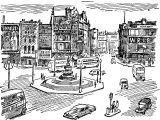
Piccadilly Circus is a square in the central part of London. It is heart of the West End. It is called a circus because it is round. In the centre of the circus stands the bronze statue to Eros on high pedestal above the fountain. London's best-known theatres and cinemas and most famous restaurants are on Piccadilly Circus. In the square you can see people of many nationalities and hear a lot of different languages.
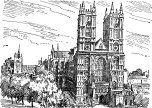
Westminster Abbey is the historic building in London to which every visitor sooner or later goes. The Abbey was founded in the 11th century as a monastery. Later it was rebuild by Henry III. The present building dates from about 1480. William the Conqueror was crowned here on Christmas Day, 1066. And it is became a tradition to crown kings and queens in Westminster Abbey. Many of Great Britain's famous men are buried in Westminster Abbey.
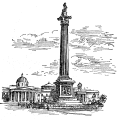
Trafalgar Square is in the centre of the West End of London. It was named so in commemoration of the victorious battle of Trafalgar in 1805. In this battle Admiral Lord Nelson was fatally wounded. That’s why, in the centre of the square there is Nelson's Column with the figure of the great seaman. Trafalgar Square is one of the busiest places in London and the place where mass meetings and demonstrations for peace and for working people's rights take place.
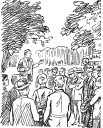
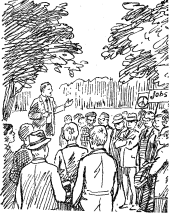 London has many parks. Londoners call them the “lungs of London”. Hyde Park is the largest public park in the West End of London. In spring and summer Londoners spend their time there. They walk, sit, and play on the grass. In the 19th century it became a popular place for public meetings. Since then "Speakers' Corner" has been the place for public gatherings of all kinds. The speakers who now come here to talk on many different themes are the most popular sight for tourists.
London has many parks. Londoners call them the “lungs of London”. Hyde Park is the largest public park in the West End of London. In spring and summer Londoners spend their time there. They walk, sit, and play on the grass. In the 19th century it became a popular place for public meetings. Since then "Speakers' Corner" has been the place for public gatherings of all kinds. The speakers who now come here to talk on many different themes are the most popular sight for tourists.

Tower Bridge was build across the Thames in 1894. Tower Bridge is a fine example of Victorian engineering in London. It is the only Thames Bridge, which can be raised.
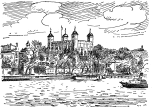








The Tower of London is the most famous of all the historical buildings in London. It stands today almost unchanged since first it was built in the 11th century. In the early days of the history of England the English kings lived in the Tower. Then it was a prison where many people died. Black ravens had much food near the walls of the Tower in those days. They live in the gardens of the Tower now. A man looks after them and gives them meat. In the Tower there is a document in which the names of all birds, their numbers and military career can be found. The English people like them very much. Now the Tower of London is a museum.

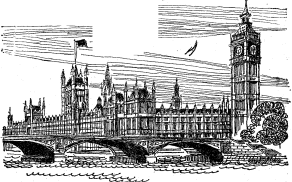




 The Palace of Westminster is usually known as the Houses of Parliament. It is very large building which stands near the Thames. On October 16, 1834 it was almost destroyed by fire. The modern palace was begun in 1840 and in 1849 Queen Victoria opened First Parliament there. There two tall towers at the corners of the building: the Victoria Tower and the Clock Tower. The Union Jack, flying from Victoria Tower, shows that Parliament is in session.
The Palace of Westminster is usually known as the Houses of Parliament. It is very large building which stands near the Thames. On October 16, 1834 it was almost destroyed by fire. The modern palace was begun in 1840 and in 1849 Queen Victoria opened First Parliament there. There two tall towers at the corners of the building: the Victoria Tower and the Clock Tower. The Union Jack, flying from Victoria Tower, shows that Parliament is in session.

 Buckingham Palace is the official London residence of the Queen. It was built in the 18th century and rebuilt later by the architect John Nash. The first Queen to live there was the young Queen Victoria.
Buckingham Palace is the official London residence of the Queen. It was built in the 18th century and rebuilt later by the architect John Nash. The first Queen to live there was the young Queen Victoria.
The Royal Standard flying over Buckingham Palace is the sign that the Queen is in the residence. The absence of the Royal Standard over the east front of Buckingham Palace means that the Queen is absent from London.
Royal Horse Guards ceremony always arouses the interest of visitors. They specially come to the Palace gates to watch it.
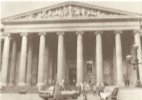 The British Museum was founded in 1753. It has many departments covering a vast variety of subjects. One of its most interesting sections is the National Library. It has more than six million books. The library receives nearly two thousand books and papers daily. The National Library has a copy of every book printed in the English language. The Library of the British Museum has a very big collection of books and manuscripts both old and new. There are also some of the first English books printed by Caxton. Caxton was a printer. He lived in the 15th century. He made the first printing-press in England. Many famous men read and studied in the Reading Room of the British Museum.
The British Museum was founded in 1753. It has many departments covering a vast variety of subjects. One of its most interesting sections is the National Library. It has more than six million books. The library receives nearly two thousand books and papers daily. The National Library has a copy of every book printed in the English language. The Library of the British Museum has a very big collection of books and manuscripts both old and new. There are also some of the first English books printed by Caxton. Caxton was a printer. He lived in the 15th century. He made the first printing-press in England. Many famous men read and studied in the Reading Room of the British Museum.
T. Good. I have two rebuses for you. Try to understand what sights are codified there.
T. OK. You know that London is famous for its history. Let’s come back to the history of London and remember what happened many, many years ago. This game is “True or False”. I’ll make some mistakes in my information and you are to find them and correct.
1. Many, many years ago the Greek (Romans) came to England. They built the town on the river Severn (Thames). The name of this town was Londinium. The Romans built Londinium near the sea (river). Besides it the Romans built a bridge over the river. They built roads to other parts of Britain.
2. I would like to say that in 1766 (1066) William the Conqueror and his people went to England from Normandy in France. William became the King of Oxford (London). Many of his people lived in London too. But William was afraid of French (English) that's why he built the Tower of London to live in it.
3. 1666 was the year of Great Flood (Fire) in London. It was started in the house of King's baker, near the Tower (London Bridge). The streets of old London were narrow and crooked, so the fire spread quickly. A strong wind was blowing from the river and it blew the flames from house to house. The fire destroyed 50 (80) % of the city. More than 250 thousand people didn't have home any more. After the Great Fire people built a new village (city). The new houses were built of brick or stone, not wood. The streets were wider and cleaner.
4. Until 2049 (1749) there was only one bridge over the river: London Bridge. I must say the old London Bridge looked very beautiful (strange). There were theatres (houses) and shops on the bridge. In the 19th century there were many new bridges in London. Now there are less (more) than 27 bridges over the Thames.
T. OK. We have spoken a lot about London’s sights, but we haven’t said a word about English people. Let’s say about them with a poem.
They dress in what they like
They are interested in sport
They take part in all activities
If they think they ought.
They all succeed in doing
Their work in five short days,
Which leaves them two the longest ones
To spend in different ways.
Then some indulge in gardening
Or walking in the rain.
And some delight in cricket,
Or in riding in the plain.
In In spite of what's around him
The real Englishman
Does crosswords in the newspaper
In pencil – if he can.
Involved in any accident
The English take a pride
In being unemotional.
They take things in their stride.
In any circumstances
Whatever they may be -
The English solve their problems
With an English cup of tea.
T. You are the best. The next game is “A Dark Horse”. I have portraits of some famous English people. Listen to the fragments from their biographies and try to guess them.
He was born in the north of Scotland in 1759.His father was poor, but he wanted to give his son the best education he could. He began to teach him to read and to write. He began to write at the age of 15. He wrote about his native country and the life of poor people. He died at the age of 37. (Robert Burns)
This person is the famous naturalist and thinker. He was born in 1809. His family lived not far from the river Severn. His father wanted him to become a doctor. At 16 he was sent to Edinburgh University to become a doctor. But he was interested in natural history. He understood that plants and animals do not always remain the same that they really change. In 1871 he published the book “The Descent of Man”. He was buried in Westminster Abbey. (Charles Darwin)
He was a great English sailor who discovered many new lands. He was born in a small village near the sea. When the boy was 17, he found work in a shop, but he decided to be a sailor. He discovered New Zealand and Australia. He died on the Hawaiian Islands. (James Cook)
This man was born in 1564 in Stratford –on-Avon. His father was a rich man and gave him a good education. He was fond of English folk-songs and ballads. He founded a theatre himself. Its name was “The Globe”. (W. Shakespeare)
T. Our game is over. I’d like to listen to the jury. What is the score and who is the winner? Taking into account your activity during the game and the number of the correct answers your marks are… Thank you for participating in the lesson. I hope you liked it.
1


про публікацію авторської розробки
Додати розробку
